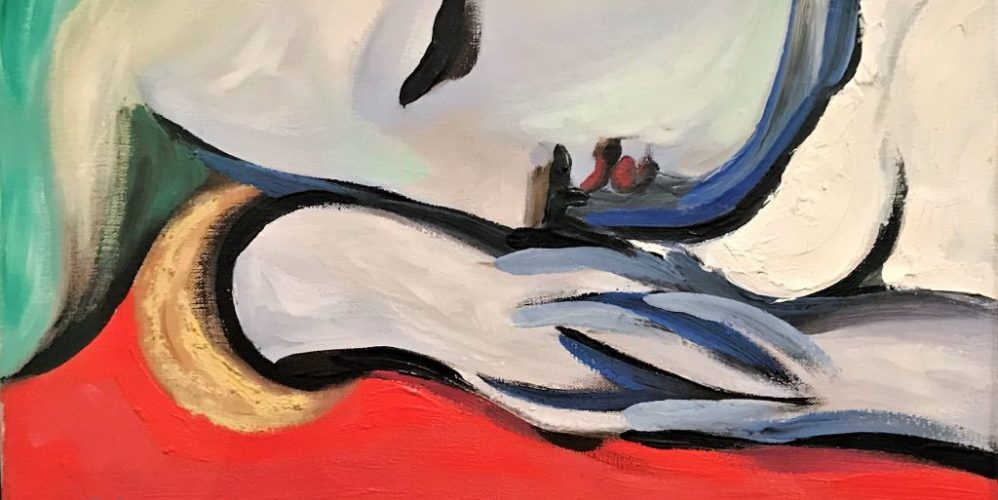The year 1932 was a wonder year for Pablo Picasso. In 366 days he made hundreds of masterpieces. Museum Tate Modern shows a large selection of the art from that year in the exhibition ‘Picasso 1932 – Love, Fame, Tragedy’.
Pablo Picasso (1881 – 1973) regarded his visual art as his diary. Even if you consider that 1932 was a leap year, the diary that this artist kept in that year was filled abundantly. Others can’t produce during their entire lifetime what Picasso made in one year: he painted, etched and sculpted hundreds of masterpieces in 366 days. Tate Modern, the popular London museum of modern art, founded (following the Paris Picasso Museum) an exhibition with works from 1932. The Spanish-born artist living in France was fifty years old, he was at the peak of his fame and his production was unprecedented. The world economy crumbled, but Picasso was still doing well for the time being. He was one of those rare artists who had success during his lifetime.

The world was on the eve of a new war in 1932, but Picasso was mainly occupied with his art. He sculpted, drew, etched and painted at a furious pace, but he was also involved in his first own museum exhibition at the Kunsthaus in Zurich. Critics were impressed by Picasso’s work that was difficult to pigeonhole within existing artistic movements, but that overwhelmed its viewers. Tate Modern created a mini-exhibition within the large exhibition, that shows Picasso’s earlier work between the art from 1932. This early work, including a portrait of Picasso’s wife Olga, a painting of their son Paulo as a harlequin and a self-portrait is more realistic, than the later more abstract canvases.

In 1932, everyday life was central to Picasso’s work. In addition to drawing and painting scenes from his living environment (Paris and Boisgeloup), ‘the woman’ was his favorite subject. Until then, he had mainly portrayed his wife Olga, but he increasingly focussed himself on the athletic shape of an initially faceless woman, in which Marie-Thérèse Walter can be recognized. Picasso had met her 5 years earlier as a 17-year-old girl at the door of the Parisian department store Galeries Lafayette and he was so impressed by her well trained body and her classic features that he asked her if she wanted to pose for him. Picasso and Marie-Thérèse started a long-term secret relationship. During family holidays on the French coast, Picasso rented a hotel room for his young mistress so that she was always nearby. If Picasso was in love, you could see that in his work. The explosive colourful canvases from the first half of 1932 reflected his love for the 28 years younger Marie-Thérèse. Picasso’s artistic experience and his creative guts led to a stunning visual freedom. That Olga had no suspicion, surprises after watching the dozens of erotically charged portraits of the blonde young woman. Picasso’s marriage did not end until years later after Marie-Thérèse had been given birth to his child. Four years after the death of Picasso, Marie-Thérèse put an end to her own life.

The sun did not shine exuberantly all year round. In the autumn of 1932 Picasso used pencil and ink more often and he gradually changed to shades of grey. The exhibition at Tate Modern shows the diversity of Picasso’s work. Picasso was a man of extremes: he exchanged a voluptuous bullfight with the delicate application of a fragile butterfly on the canvas. Love and eroticism also had different faces with Picasso. His infatuation with Marie-Thérèse brought not only joy but also inner restlessness. On one occasion he attacks ‘the woman’ as a raping Minotaur, as if he wanted to be redeemed from his all-consuming passion, but in a subsequent portrait he portrays a sleeping woman as if he watched her with a paternal look. Women can be equipped with dangerous octopus tentacles, but the next moment they listen peacefully and mesmerized to a lovely musician flute player.

The most moving works can be seen at the end of the exhibition. On ‘The Rescue’, Picasso drew and painted a woman who is pulled out of the water in several versions. Marie-Thérèse had fallen from her kayak in the river Marne in 1932 and she almost drowned on that occasion. She ended up with a serious infection in hospital and she spent months on the brink of death. This confronted Picasso with his deepest fear: losing what was dear to him. As a child Picasso had experienced that his seven-year-old sister Conchita had died of diphtheria, an event that never completely disappeared from his thoughts (and his work). In his work he tried to hold on to what he could lose in real life. The latest version of ‘The Rescue’ shows the same female person twice. One pulls the other out of the water. It is a powerful imagination of someone who realizes that fate will strike irrevocably, but who tries to postpone that moment as long as possible. As a wizard with images, Picasso surpassed many others, but even he could not perform real wonders.

The EY Exhibition: Picasso 1932 – Love, Fame, Tragedy
The Eyal Ofer Galleries, Tate Modern, Bankside, London SE1 9TG
Opening hours:
Sunday to Thursday 10.00-18.00
Friday and Saturday 10.00-22.00
Still on view until 9 September 2018





